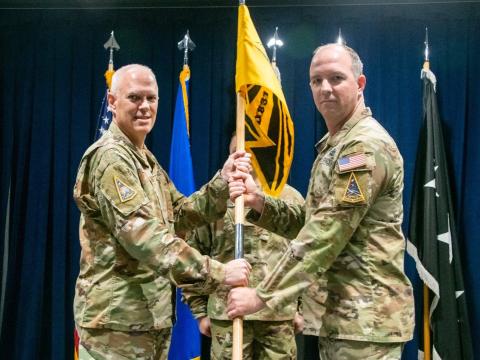Presenting ‘Dilemmas’ to Russia in the High North
With the strategic importance of the Arctic and Russia’s increased activities in the polar region, a coordinated NATO approach is necessary. The U.S. military has focused on growing its cold-weather operational capabilities in the region over the last decade, with help from Norway and other countries and now from new NATO members Sweden and Finland.
Since 2016, the U.S. Marine Corps, through host Norway, has maintained a long-term presence in the Kingdom of Norway. Learning from the Norwegian Army, the Marines—beginning with Marine Rotational Force-Europe (MRF-E) groups—have worked to train and develop the skills necessary to operate in the Arctic’s extreme conditions.
And even before Russia’s illegal invasion of Ukraine in 2022, U.S. defense policy put a priority on Arctic operations in the high north to support a “secure and stable region” and deter Russian aggression, which is now more important than ever.
Together, the allies are presenting dilemmas to Russia, said Lt. Col. Jason Jones, USMC, assistant chief of staff, G-6, U.S. Marine Corps Forces Europe and Africa (MARFOREUR/AF).
Jones spoke on a panel at AFCEA’s TechNet Transatlantic in Frankfurt, Germany, on December 5, along with Maj. Gen. John Phillips, director, J-6, Cyber and C4, U.S. European Command, and Phillips’ deputy, Col. James Austin, USA.
Located in Stuttgart, Germany, MARFOREUR/AF has service responsibilities to both the U.S. European Command and U.S. Africa Command. MARFOREUR/AF’s main force provider—the II Marine Expeditionary Force—comes out of the U.S. East Coast and primarily partners with Norway, Sweden, Finland, and to a lesser extent, some of the other allies, Jones explained.
“The Marine Corps has a traditional role in the high north,” Jones said. “We closely partner with Norway, and we conduct our largest exercises there, in either Norway, Sweden or Finland. We spend a lot of time in the high north, which is unusual for the Marine Corps as a force.”
“Why does the Marine Corps do operations of that size in the high north?” Phillips posited. “Because it gives dilemmas to our adversary. They have to be distracted by the capability that is in the high north and can't just focus on the open plains of Ukraine—and Poland if that fight were to occur.”
The U.S. military does face challenges though in that area, the leaders said.
For the Marines, in addition to working on how they deploy for MARFOREU/AF activities in support of the two combatant commands as well as to NATO, one of the main challenges centers around setting up communications (comms) in the Arctic, efforts of which are hampered by the remoteness, being at the pole and the punishing climate.
“That experience in the high north for the Marines has been challenging from a communications perspective,” Jones confirmed. “When I first came into this job three years ago, I inherited a ‘how we're going to get healthy in the high north’ plan. And it was a really well-laid out campaign plan that identified the main challenges that we as a force had been facing in the high north. And the across the spectrum, it was SATCOM [satellite communications]. SATCOM did not work well in the high north, especially for those units who were looking for tactical positions.”
The Army general echoed these concerns, seeing firsthand the comms difficulties in a visit last March to Finland’s Arctic Circle with joint Marine partners. “Even getting Starlink, Starshield up and on the network in that high terrain was difficult and challenging,” Phillips said.
Jones has seen additional comms infrastructure projects come to fruition that helped “dramatically,” along with the planned NATO Secret Mission Partner Network. In addition, improvements to the low earth orbit satellite constellations are providing more flexibility.
“I would also say our collaboration with the Norwegian Self Defense Force, the joint headquarters for Norway, their cyber force has been tremendously helpful,” Jones noted. “When Marines go to Norway, we are able to work very closely with them. We're able to utilize a lot of the fiber infrastructure that's already in place in the country so that if we go to a military site, they will generally provide comms transport for us via the fiber infrastructure.”
Also helpful is the in-country continued proliferation of the 4G and 5G cellular networks that provide an additional path to their transport plan, making operations easier.
“But I think our most important collaboration moving forward is focused around having an MPE [mission partner environment] network that is seamless, that is fully interoperable across the spectrum of the services that we're offering and, most importantly, the fires, intelligence and command and control systems, linking those together,” the Marine explained. “And overcoming some of the protocols and standardization challenges that I think we still face.”

Phillips recognized that NATO’s evolution alone brings further military capabilities to the Arctic and to the alliance.
With 32 nations now, NATO is much larger than the 16 members that the general saw in 1997 when he was first stationed in Europe. And with this larger group comes more resources. New member Finland is going to have three times the number of F-35s than the United States will have in Europe, the general offered.
“Finland will have that many F-35s,” he said. “We are going to have over 600 F-35s, fifth-generation aircraft by 2032, inside this theater. And fewer than 10% are going to be flown by American pilots.”
In addition, the land forces will offer tank capabilities. “Poland, in this open-source environment, is going to have 1,200 tanks by the end of the decade,” Phillips stated. “That is about a third of the entire size of the United States' military and armor structure in Europe. And more than 200 of those tanks are going to be M1 tanks.”
And rounding out to the Russian border are eastern European NATO members, the general continued.
“And then our new partners and capability that we have in the Black Sea region, with phenomenal partners like Romania and Bulgaria, and providing, again, dilemmas to Russia in the Black Sea,” he stated. “That's why we do the things that we do, to give them multiple problem sets to look at.
“That is the capability that we all bring to the fight,” the general stressed.
TechNet Transatlantic is organized by AFCEA International in conjunction with the AFCEA Europe office. SIGNAL Media is the official media of AFCEA International.





Comments